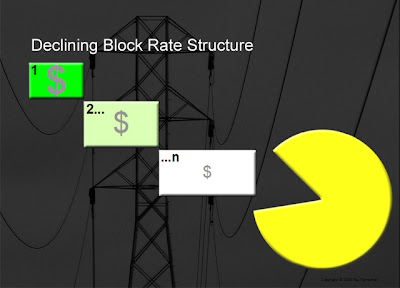When an electricity rate plans incorporates a block structure there are important ramifications for avoided costs. In an inclining block structure, electricity is first purchased at a relatively low price until the upper limit on the initial block is reached. Electricity purchased in subsequent blocks is increasingly more expensive. In an inclining block structure, the electricity generated by a supplemental solar electric energy system first eliminates electricity purchases from the most expensive block.

Conversely, in a declining block structure, the electricity generated by a supplemental solar electric energy system first eliminates electricity purchases from the least expensive block.

In order to achieve maximum return on investment from a solar electric energy system – or an investment in any energy management strategy – it is important to eliminate the most expensive purchased energy.
The visualization for the average summer monthly retail electricity cost for the Arizona Public Service (APS) E-12 standard residential rate plan (with an inclining block structure) exposes an almost flat pricing scheme, but an investment in solar will first eliminate expensive energy.
The visualization for the average summer monthly retail electricity cost for the Arizona Public Service (APS) E-32 commercial rate plan (with a declining block structure) exposes a pricing scheme that slopes down as both consumption and demand increase. An investment in solar under this rate plan will first eliminate the least expensive purchased energy.
Also, in the APS E-32 commercial rate plan, not only can solar not control billing demand, but the uncontrollable demand is used as a multiplier for the first block of the most expensive purchased energy!
Double whammy!






No comments:
Post a Comment